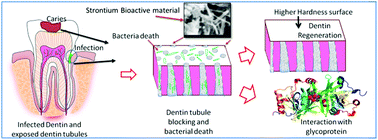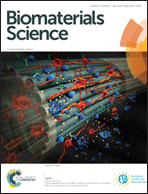Highly reactive crystalline-phase-embedded strontium-bioactive nanorods for multimodal bioactive applications†
Abstract
In the present work, a crystallization-induced strontium-bioactive material, with a composition similar to Bioglass 45S5 system, was obtained using a sol–gel-assisted microwave method with nanorod morphologies of 30–80 nm in size. The effect of crystallization induced in the glass network, and its influence on the bioactivity and mechanical properties of bone and dentin regeneration, were the main novel findings of this work. Rietveld analysis of X-ray diffraction spectra showed the best fit with sodium (combeite, Na2Ca2Si3O9) and calcium (clinophosinaite, Ca2Na6O14P2Si2; calcium strontium silicate, Ca1.5O4SiSr0.5; and calcium carbonate, CaCO3) enriched crystal systems. Multinuclear solid-state NMR studies provided detailed atomistic insight into the presence of crystalline mineral phases in the bioactive material. The dentin matrix and antibacterial studies showed good results for 5% strontium-substituted calcium compared with basic 45S5 composition due to its smaller particle size (30 nm), which suggested applications to dentin regeneration. Simulation studies have been demonstrated with clinophosinaite crystal data from the XRD spectra, with the glycoprotein salivary metabolites also showing that 5% strontium-substituted calcium has a higher binding affinity for the salivary compound, which is suitable for dentin regeneration applications. In vitro apatite formation studies showed that this material is suitable for bone regeneration applications.



 Please wait while we load your content...
Please wait while we load your content...